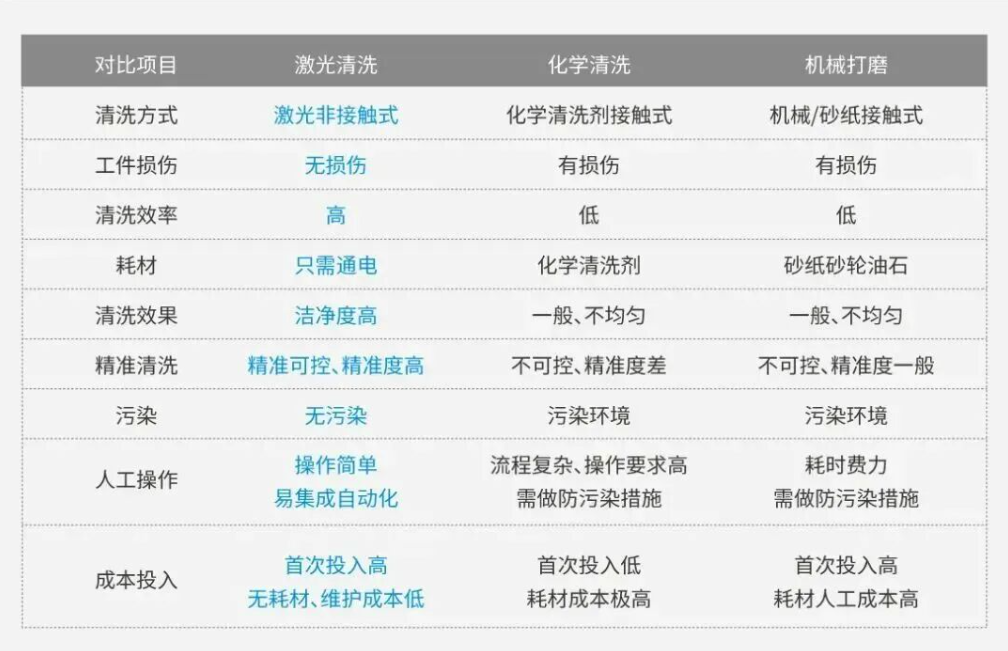Laser Cleaning Technology: Main Applications in the Automotive Industry
Laser cleaning is hailed as “the most promising green cleaning technology of the 21st century.” Compared with traditional cleaning methods, it boasts distinct advantages such as environmental friendliness, easy automation, high efficiency, high precision, and non-contact processing. In recent years, it has been widely applied in industrial production, including automotive manufacturing, aerospace, precision electronics, medical equipment, and shipbuilding. Complete application solutions of laser cleaning technology are available for electric vehicle batteries, motors, electronic controls, vehicle bodies, and automotive components.
Laser Cleaning Before and After Automotive Welding
It removes contaminants such as oil stains, rust, oxide coatings (e.g., galvanized layers), and release agents from welding areas (e.g., body panels, chassis components, battery trays). It significantly improves welding quality and strength, reduces welding defects (e.g., porosity, insufficient welding), and enhances welding yield. Pre-welding cleaning is crucial — laser cleaning eliminates impurities like oil, dust, and oxide layers from welding positions, ensuring welding strength and reliability. A case study from BMW Group shows that this technology can increase cylinder block cleaning efficiency by 65%, and reduce welding defect rate to below 0.02% by precisely removing 0.1-0.3mm thick oxide layers.
Cleaning and Maintenance of Automotive Molds
It removes release agent residues, carbon deposits, polymer residues, and oxides from the surfaces of stamping molds, injection molds, casting molds, etc. It restores mold surface finish, guarantees product quality (e.g., surface finish of body stamping parts), extends mold service life, and reduces downtime for maintenance.
Power Battery Manufacturing
- Electrode sheet cleaning: Eliminates oil stains and oxides from the surfaces of metal foils (copper foil, aluminum foil) before coating lithium battery positive and negative electrodes, improving the adhesion of coating slurry.
- Pre-welding cleaning: Cleans oxides and insulation layer residues from welding areas such as battery tabs, connecting sheets, and Busbars, ensuring welding quality and reducing contact resistance.
- Pre-welding cleaning of sealing nails: Cleans the welding area of battery cover sealing nails to ensure welding tightness.
Cleaning of Automotive Components
It is used to clean oil stains and impurities from the surfaces of components such as engine blocks, crankshafts, and connecting rods, improving assembly precision and performance. It ensures the normal operation of the transmission system and reduces wear and failures. For brake discs and brake pads, it can remove surface oil stains, colloids, and rust, enhancing braking performance and ensuring driving safety.
Automotive Maintenance and Refurbishment
- Local rust/paint removal: Precisely removes local rust or damaged paint layers on the vehicle body.
- Cleans oil stains, carbon deposits, rust, and old coatings from repair areas such as engine blocks, cylinder heads, and gearbox housings, maximizing the retention of the original metal substrate. Equipped with a machine vision system, laser cleaning can automatically identify rusted areas and plan optimal scanning paths, processing 1 square meter of rusted surface in just 8 minutes.
Automotive Motors
Laser stripping of flat copper wires: It can effectively strip paint layers, film coatings, PEEK layers, etc., from the surface of flat copper wires without damage, with a stripping time of less than 0.6 seconds per cycle.
Automotive Electronic Controls
Laser cleaning of IGBT copper bars: By laser cleaning semi-finished products after welding, it ensures the surface cleanliness of IGBT chips meets the requirements for wire bonding.
Laser cleaning equipment can not only perform surface rust removal, paint removal, oxide layer removal, and oil stain removal on various automotive components
(such as wheels, brake pads, hoods, and engines) but also maintain stable long-term costs with low operating costs, low maintenance rates, and no additional consumables. It can also save enterprises certain labor costs and, more importantly, facilitate automated operations.
With the popularization of high-power pulsed cleaning equipment and the maturity of AI control systems, laser cleaning will surely drive automotive manufacturing towards a more efficient, environmentally friendly, and intelligent direction, injecting core momentum into the upgrading of the automotive industry.
Post time: Nov-06-2025

















